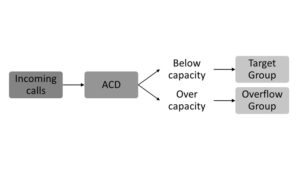What is Overflow?
Overflow occurs when unanswered calls are moved from one target group to another. This usually happens because the original target group is nearing, or has reached, its call handling capacity.
The ACD has a trigger, signalling when calls should be overflowed, which is often based on a maximum threshold for queue time.
The overflow group may be an automated answering service or another department of the contact centre. Overflow traffic can also be directed to outsourcers. These service agents may have similar training to in-house agents, or might arrange outbound calls to customers for a later date.

Preventing Overflow
Overflow capacity is a resource which can be deployed deliberately. This is most often the case when brief periods of high traffic are expected and using overflow is more cost effective than scheduling additional agents.
However, a regular reliance on unplanned overflow usually indicates inadequate or misallocated resources. When calls overflow it is helpful to know what, if anything, went wrong. Planners should establish whether target groups are routinely overflowing at certain times of day, and why forecasting efforts are not anticipating this.
If forecasting is functioning accurately, the challenge is to understand how to translate this information into corresponding scheduling practices. The problem may be a simple situation that has been overlooked. For example, it’s possible that non-call activities such as training and breaks are being taken by too many staff members at the same time.
In smaller contact centres, call volume is sometimes too erratic to plan for closely, and flexible scheduling might be needed to keep the right staffing levels affordable. Otherwise, managers must decide if it is more cost effective to oversubscribe agents, or rely on BPOs. Cross training in-house agents to fulfil other roles may enable centres to affordably maintain high staff levels.
There are also technological solutions that can help reduce queueing, the most common being the virtual queue. A virtual queue is itself an overflow group, operating on a ‘First In, First Out’ (FIFO) basis, allowing callers to hold their place in the queue without staying on the line.
One rea to watch with overflow calls is with call abandons. Depending upon how the system is set up the call may have been classed as an abandoned call on both the target group and also on the overflow group.
The most important lesson is not to make the mistake of rerouting calls to anyone who is not trained to handle them. In the rush to lower call wait times, managers sometimes adopt an ‘all hands to the pumps’ attitude. However, reducing the queue should not be considered an end in itself, and if the advisor on the line is not competent to the task, they are not helping anyone.
Author: Jonty Pearce
Published On: 2nd Aug 2016 - Last modified: 26th Apr 2022
Read more about - Definitions, Call Handling















